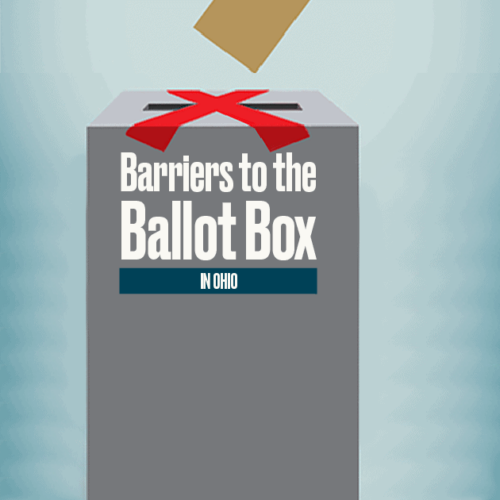Introduction
Ohio voters are requesting absentee ballots at a rate that’s already more than double the total for the entire 2016 election, but must overcome a series of barriers put into place by the state’s Republican-controlled legislature and secretary of state.
And obstacles to voting in Ohio go beyond absentee voting. The state has purged thousands of voters from the rolls for not voting frequently enough and has a strict voter ID law in place.
Sign up for The Moment newsletter
Our CEO Susan Smith Richardson guides you through conversations and context on race and inequality.
Ohio’s role as a potential battleground state in this fall’s presidential election has led to an array of lawsuits and appeals over these provisions.
Here’s a look at some of the most significant barriers to voting rights and access in the state:
Limited drop boxes
Ballot drop boxes provide a way around any potential delay in the delivery of ballots and offer a safer alternative to those afraid of risking their health by standing in a long line at a polling place. At least 38 states and Washington, D.C., are utilizing drop boxes for the upcoming election — and Ohio is one of them.
But Secretary of State Frank LaRose, a Republican, issued instructions in August, prohibiting the state’s 88 counties from installing more than one drop box each, regardless of the geographic size and population of the county.
For example, rural Vinton County, population 13,000, will have the same number of drop boxes this fall as Franklin County, which includes the city of Columbus and has a population of more than 1.3 million. And Ashtabula County, which at more than 700 square miles is more than half the size of Rhode Island and three times as large as Ohio’s Ottawa County, will still have only one drop box.
The move came despite a July request from the A. Philip Randolph Institute, a voting rights group, to make “voting amid the pandemic easier and safer” by installing multiple ballot drop boxes in each county.
The Ohio Democratic Party sued LaRose over his decision, saying “limiting drop boxes will suppress votes.” The A. Philip Randolph Institute and the League of Women Voters of Ohio also filed a lawsuit.
Jen Miller, executive director of the League of Women Voters of Ohio, said one drop box location per county is not accessible for many voters. “We have counties where someone may have to drive more than a half an hour one way to drop off their ballot,” she said.
“There is nothing in the Ohio statute restricting boards of elections from providing more than one drop box,” Lisa Tong Parola Gaynier, board president of Northeast Ohio Voter Advocates, said in an email. “There is no logical rationale for the decision he has imposed on citizens of this state.”
LaRose argued that he did not have the legal authority to allow multiple drop boxes in each county, but a panel of appeals court judges disagreed. Following the ruling, LaRose issued a directive on Oct. 5 to clarify that it’s up to county election officials to decide the number of drop boxes — but they must be located at the board of elections’ property.
But a federal judge blocked LaRose’s directive, saying location restrictions on where drop boxes can be placed are “arbitrary.”
LaRose appealed the ruling at the 6th Circuit Court of Appeals, which has agreed to allow his directive to remain in effect while the case is decided.
Catherine Turcer, the executive director of Common Cause Ohio, said even if the court allows additional drop boxes in coming weeks, it might be too late.
“We are already voting. People already have their ballots,” Turcer said.
Rejected applications
In July, the League of Women Voters of Ohio and the A. Philip Randolph Institute filed a lawsuit over the state’s “flawed system” of matching voter signatures on absentee ballots and applications. The American Civil Liberties Union of Ohio also filed a lawsuit seeking to require a notice to be sent to voters if they needed to correct their ballots and allow them more time to do so.
Miller said those who had their absentee ballot application or ballot rejected because of the signature matching system were more likely to be voters with disabilities, senior citizens or young people.
“Our tips are to, if you want to vote absentee, start the process early, so if you get dinged for something like a signature mismatch, you have time to address that,” Miller said. “If you had an injury or some reason why your signature has changed, put a note with your absentee ballot application and then again with your absentee ballot.”
Last month, a federal judge ruled that the system of matching signatures “is not burdensome enough to be struck down as illegal.” The system will continue through this election, the judge ruled, because making changes this close to the election would “undermine the public confidence in elections.”
The ACLU of Ohio said it will continue to make its case against signature matching and collect evidence from this year’s election to help make that argument.
A September investigation by nonprofit news outlet Eye on Ohio found that county election officials in Ohio had rejected 72,077 invalid applications for the 2020 primary — 4% of all the absentee ballots requested. Many counties failed to track the reasons for rejection; those that did rejected applications for unmatched signatures and more than 16 other reasons. The investigation found that two most common reasons were voters failing to check the box for their political party and providing birth dates that did not match voting records.
Voter ID law
Ohio currently enforces a voter ID law, signed in 2006, that requires citizens to present forms of ID to prove who they are at the polls — one of 35 states to do so. Acceptable forms of ID include bank statements, military IDs, utility bills, driver’s licenses or other state-issued credentials. Voters who do not provide ID may cast a provisional ballot that will only be counted if the voter returns to their board of elections within seven days with a qualifying form of identification.
The law almost became much more restrictive in 2011 when the state’s Republican-controlled House passed a measure requiring voters to show government-issued photo IDs at the polls. But the measure faced stiff opposition from voting rights advocates, who argued it could further suppress voters — especially voters of color, elderly, poor and college students.
“It hits different parts of the population harder than others. And clearly, when it makes it harder for people who are struggling to pay their bills, then it’s just not right,” Turcer said. “It’s unfair, and people should not have unequal access to the ballot.”
The measure ultimately stalled in the Senate.
The House Republicans have continued to try to pass a photo ID bill, but their attempts in 2014 and 2015 failed.
Purging voters
The National Voter Registration Act of 1993 required states to maintain accurate and current voter registration lists. The following year, Ohio’s state legislature established a system for purging voter lists that advocates say went far beyond that mandate: The secretary of state sends a notice to voters who haven’t cast a ballot or updated their information in two years. If the notice is not returned and the voter continues to not vote for four years, they are automatically removed from voter rolls.
In 2016, after thousands of voters were removed from voter rolls in 2015, the ACLU of Ohio filed a lawsuit on two counts, arguing that the state was unlawfully purging voters for failure to vote, and that the notices to voters were inadequate.
The lawsuit spurred what’s known as the “APRI exception” — put in place by then-Secretary of State John Husted — to allow provisional ballots to be cast in the 2016 and 2018 elections by voters who were purged.
Ultimately, the Supreme Court ruled that the state’s practice of purging voters did not violate federal laws, as the purges are triggered by failure to respond to a notice, not for failing to vote.
When the purging process resumed last year, voting rights groups quickly spotted a problem: More than one in six voters on the purge list — some 40,000 voters in all — had been flagged by mistake. The Columbus Dispatch found that about 1,600 of the voters on the list had recently cast a ballot.
The Ohio Democratic Party filed a lawsuit to stop this system of purging.
Meanwhile, the ACLU of Ohio reached a settlement agreement with the secretary of state to resolve the remaining portion of its lawsuit over the adequacy of the state’s notices to voters. Under the terms of the agreement, the APRI exception will continue through the end of 2022. It will include voters who were purged for inactivity in four election cycles between 2011 and 2019, but not before 2011 or after 2019.
The state is planning to conduct another purge of as many as 115,000 voters after this year’s election.
Voting by mail
Even though the leader of his party, President Donald Trump, has raised concerns over mail-in voting across the U.S., LaRose says those concerns might be valid in other states, but not in Ohio. He said the state has been using the process for 20 years and is “pretty good at it.”
But earlier this month, nearly 50,000 residents in Franklin County received the wrong absentee ballot in the mail. Election officials promised to send replacements within three days — but not before Trump took to Twitter to voice his concerns to Ohio voters in the upcoming election.
Just two days later, the board of elections announced that it found only “some” of the replacements were necessary, because most of the original ballots were correct after all. The exact number of replacements needed is unknown.
Correction: Oct. 15, 12: p.m.: An earlier version of this story incorrectly spelled Catherine Turcer’s first and last name.
Read more in Money and Democracy
US Polling Places
In New Hampshire, obstacles to registering, confusion over absentee ballots
And despite court victory against college voting restrictions, it won’t be easy for students this November.
US Polling Places
In Mississippi, vote-by-mail rules make it hard to actually vote by mail
Many residents do not qualify for an absentee ballot. Those who do must get their application and their ballot signed by a witness, often a notary.




Join the conversation
Show Comments